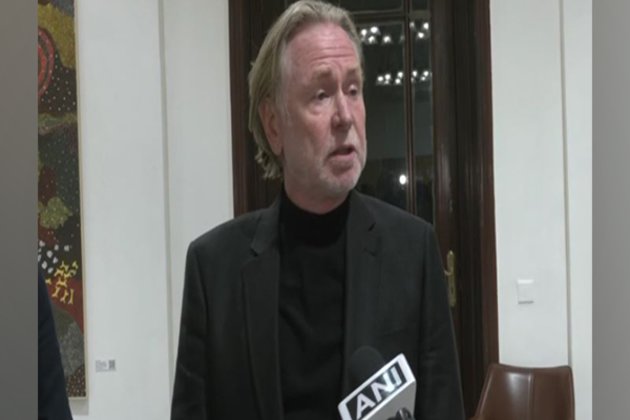2LT National News
Privileged that people travelled from Australia to see how their artwork is understood by Indian audience: Envoy Philip Green
Jan 29, 2024
New Delhi [India], January 28 (ANI): As a host of reception to launch exhibition titled ‘Modern Tribal: Connecting Traditions’, Australian High Commissioner to India, Philip Green has said that he is “privileged” to see that people have travelled from Australia to see how their artwork is understood by the Indian audience.
He underlined that it is no coincidence that “we are trying to expose Indian audiences to these artforms from our First Nations people” from Australia.
While speaking to ANI, the Australian High Commissioner said, “There are more than 250 indigenous languages in Australia, and I don’t have the skill and time to greet you tonight in all of them. It’s very special for me tonight for me to be able to be a part of your introduction to Australian artwork.””We are privileged that people have travelled from Australia to help you understand these artworks, and see how they are understood by Indian audience,” he said.
Notably, the High Commissioner of Australia, Philip Green, hosted a reception to launch the exhibition titled ‘Modern Tribal – Connecting Traditions’ at Bikaner House on Sunday.
Curated by the Gondwana Art Project, the exhibition features tribal art from Central India, alongside Australian indigenous works from New England Regional Art Museum’s (NERAM) partner, Utopia Art Sydney and South Australian-born, Darwin-based First Nations artist Sarrita King.
Green went on to say, “It is no coincidence that we are trying to expose Indian audiences to these artforms from our First Nations people.”He said, “We are very proud that even as a modern and sophisticated country in Australia, we have amongst our people, the oldest living culture on planet.””We are leading our global diplomacy with our First Nation people as a sign of respect for them, and because we believe that, that part of Australian history and culture is worthy of being at the front of Australia’s cultural diplomacy,” the Australian envoy said.
A dedicated Australian Indigenous Artworks wall will showcase pieces from NERAM’s partner, Utopia Art Sydney and from a First Nations artist Sarrita King.
NERAM is a leading cultural and arts tourism destination in regional Australia, and home to one of the nation’s most significant art collections outside the capital cities. The exhibition continues from January 29-February 5.
“I am really grateful to be here in India. This series is all about connecting to our own ancestors. I am excited to be in India and have those tribal connections, as you know Australia is very rich in Aboriginal culture,” First Nations artist Sarrita King told ANI.
Meanwhile, Sundeep Bhandari, Gondwana Art Project Founder said that he decided to set up a foundation to support the tribal artists.
On Gondwana Art Project, he told ANI, “We decided to set up a foundation to support the tribal artists. And, the Gondwana art project was set-up to essentially support the livelihoods of these tribal artists, while mentoring them, helping them design concepts on developing something which is very modern and contemporary for the global world, not just focused on limited market in India. It is more of my social project, nota profit project.””The Bheel and Gond art from Central India uses similar techniques, which the aboriginal art in Australia uses,” he said.
Curated by the Gondwana Art Project, the exhibition features tribal art from Central India, alongside Australian indigenous works from New England Regional Art Museum’s (NERAM) partner, Utopia Art Sydney and South Australian-born, Darwin-based First Nations artist Sarrita King.
The Gondwana Art Project has been mentoring tribal artists from Central India in developing artworks with new design concepts and colour palettes, thus supporting their livelihood.
These artworks are done in a modern and contemporary style keeping intact the authenticity of the traditional artforms, narrating stories of tribal culture, festivals, environment, folklore, flora and fauna. (ANI)



